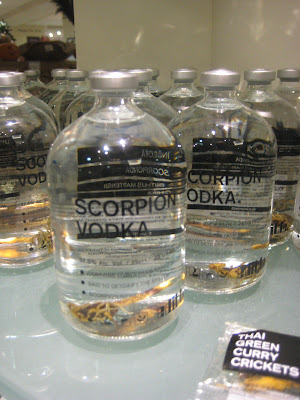
Look at this ice bucket. Seem familiar?
I'm betting it does. For the generation that came of age after WWII, this was their ice bucket. It must have been cheap and easy to find (Woolworths? Macy's?), because everyone had one. For the generation that grew up in the '60s and '70s, this was their parents' ice bucket. It made a regular appearance every day around cocktail hour. For today's younger generation, it is a collector's item. The bucket can be found in nearly every corner antique store, going for anything from $25 to $80.
My parents owns a penguin ice bucket. I never thought much about it as a kid, though some part of me enjoyed to look of it. Penguins are soothing figures, especially to a child, and I'm sure the elegance of the Art Deco design was doing a number on my eyes as well.
The bucket seems to be held in some esteem by the drinking cognescenti. There is one on display in the new Museum of the American Cocktail in New Orleans. Imagine my stunned reaction when I saw that knick-knack under glass.
I have the same bucket today. I wish I could say it was my parents, but no—they still own and use theirs. I bought mine at a kitschy second-hand shop. Think I got it for $10, which is a steal these days. (I would refuse to pay $80 for an item I know my mom and dad picked up for $6.99.)
I've learned something about the bucket recently that makes me feel even more proprietary about it. It was made by the West Bend Aluminum Company in West Bend, Wisconsin, not a stone's throw from where I grew up. No wonder my parents owned one!
The items official name is the West Bend Penguin Hot and Cold Server Ice Bucket. (So, what? I could serve soup in it?) I'm not judge of metals, but it's either aluminum or stainless steel. It also came in a copper-colored version, which is much more rare. The sloping handles, which look like penguin wings, and the top handle are wood on mine, but other versions had Bakelite handles, either in brown or black. Not sure which type of bucket is more valuable.
The Patent on the bucket is No. 2,349,099 and Des. 127,279. The design was filed March 13, 1941 and issued May 20, 1941; the patent was filed May 19, 1941 and issued May 16, 1944. Nonetheless, the bucket really had its heyday in the 1950s and early 1960s.

About the West Bend Aluminum Company, it was founded in 1911 by young Bernhardt C. Ziegler. Sears & Roebuck was an early customer of their products. The Waterless Cooker, a large pot with inset pans, was a success for the company in the 1920s. In 1932 it introduced a "Flavo-Seal" line of heavy-gauge cookware made of up roasters, saucepans, and skillets. The factory produced war-related goods during World War I, World War II and the Korean War. In 1961, it changed its name to the West Bend Company. It continued to grow throughout the decades and was bought by Premark's Consumer Products Group in 1995. There was still a big plant in West Bend until recently, but many others as well, including "West Bend de Mexico" in Renosa, Mexico.
And then this:
In 2003, The West Bend Company was acquired by Focus Products Group, LLC, an investment and growth oriented holding company headquartered in Vernon Hills, IL, and renamed West Bend Housewares.
In early 2007, Focus Products Group acquired Back to Basics Products, an inventive housewares company based out of Utah. Back to Basics was combined with West Bend Housewares to create Focus Electrics, a new leader in innovative kitchen appliances at competitive prices. This merge strengthened and expanded both lines to bring the consumer a wider range of inventive, seasonal and traditional appliance options for their kitchen.
Focus Electrics. Doesn't have the same ring, does it? I think business still goes on in West Bend, but I'm not sure.
























